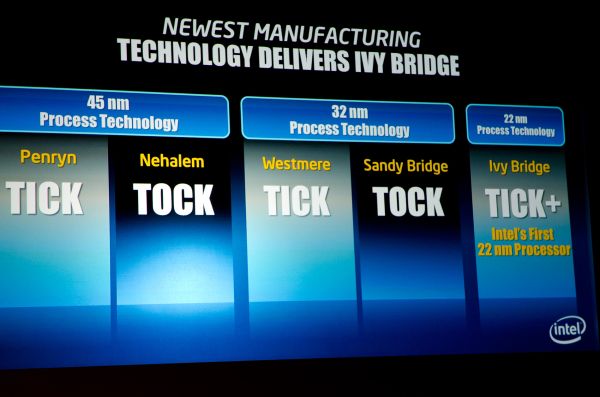Seeing as there are bound to be news/rumors/etc of Ivy Bridge, I figured I'd make a thread for it.
Just as a note, the upcoming LGA 2011 release is not Ivy Bridge, it's Sandy Bridge E, which is Sandy Bridge (obviously) with more memory bandwidth/cores and power consumption/cost. Some seem to be confused that Ivy Bridge refers to all of LGA 2011, when it does not. There will, however, be an "Ivy Bridge E" later on LGA 2011.
In other words, LGA 1155 is Sandy Bridge now, Ivy Bridge later. LGA 2011 is Sandy Bridge E coming up, Ivy Bridge E even later.
That being said, let's kick this off.
Here's an early roadmap of sorts for it.
![Image]()
![Image]()
We see TDP drop from 95W to 77W (some are even 65W), and given Intel's claims of actual "performance" increases from the new process shrink being pretty harped on, going from 95W TDP to 77W TDP isn't enough to account for all of it, so here's to hoping this is another Conroe to Wolfdale.
We also see a Core i7 2700K, which is Sandy Bridge, set to replace the Core i7 2600K in the meantime, which sadly looks to sort of become a bit of an obscurity like the Core 2 Duo E8500 did between the E8400 and E8600 in it's days (and similarly, the GeForce 4 Ti 4400 between the Ti 4200 and Ti 4600).
Just as a note, the upcoming LGA 2011 release is not Ivy Bridge, it's Sandy Bridge E, which is Sandy Bridge (obviously) with more memory bandwidth/cores and power consumption/cost. Some seem to be confused that Ivy Bridge refers to all of LGA 2011, when it does not. There will, however, be an "Ivy Bridge E" later on LGA 2011.
In other words, LGA 1155 is Sandy Bridge now, Ivy Bridge later. LGA 2011 is Sandy Bridge E coming up, Ivy Bridge E even later.
That being said, let's kick this off.
Here's an early roadmap of sorts for it.


We see TDP drop from 95W to 77W (some are even 65W), and given Intel's claims of actual "performance" increases from the new process shrink being pretty harped on, going from 95W TDP to 77W TDP isn't enough to account for all of it, so here's to hoping this is another Conroe to Wolfdale.
We also see a Core i7 2700K, which is Sandy Bridge, set to replace the Core i7 2600K in the meantime, which sadly looks to sort of become a bit of an obscurity like the Core 2 Duo E8500 did between the E8400 and E8600 in it's days (and similarly, the GeForce 4 Ti 4400 between the Ti 4200 and Ti 4600).





